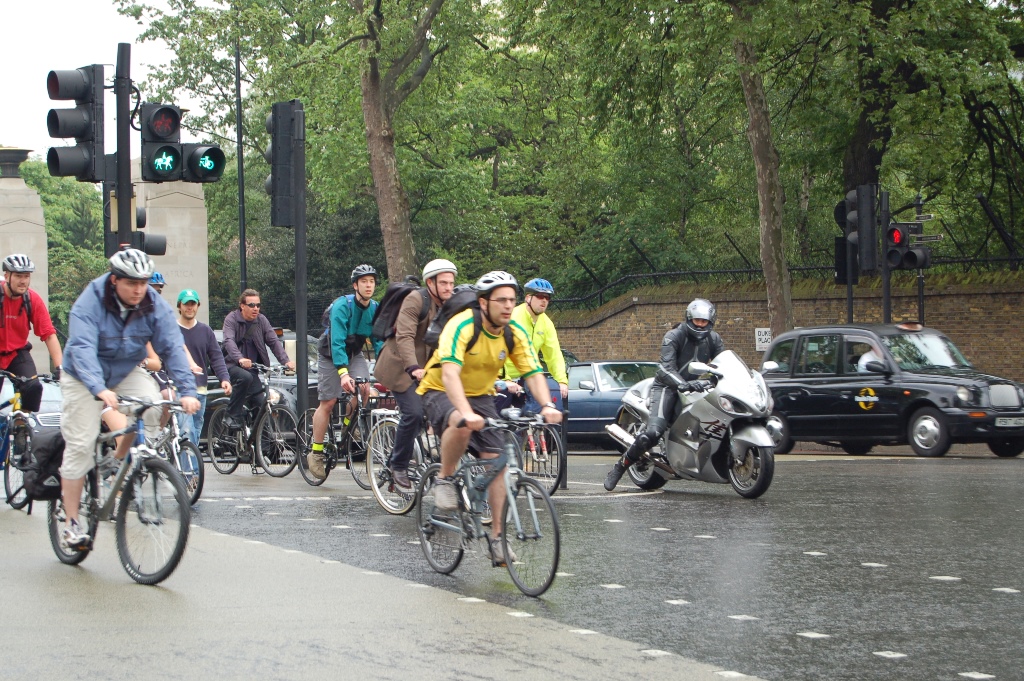People who bike hate cars. People who drive hate bikes. You’re both wrong.
I personally take issue with anybody who doesn’t follow the rules of the road, or who (through apathy, or ignorance) puts others in danger.
The Ottawa Citizen has published a few pieces in the last couple of weeks about cycling, bike lanes, the driving/cycling dynamic, and a whole lot of other stuff pitting bikes against cars on the capital’s streets.
This kind of article is hurting a relationship that could be harmonious and mutually beneficial, if everybody could just agree to follow simple rules that already exist, and not presume they are special. Let me address a few points from the latest op-ed piece in the Citizen now:
I’ve never really understood just what it is that makes riding a bicycle so special. Sure, riding a bike is good exercise and an inexpensive way to get around, but that’s all it is.
This is such an incredibly shortsighted point. Isn’t this a very valuable and noteworthy goal, especially as cost of living rises in cities and obesity skyrockets around the world? Not to mention global climate change, to which any motor vehicles (including electric cars powered by coal) still contribute.
…[T]hey claim a right to ride on sidewalks as required and to ignore the laws that apply to bicycles. All while complaining about drivers and claiming that cyclists are subsidizing motorists.
Riding a vehicle on the sidewalk is illegal. You can get a fine for doing it, whether you’re in a car, or on a bike. Yes, people do it, but it’s because they don’t feel safe on streets. We live in a car-first culture, where many people are deterred from riding bikes when they hear almost daily about collisions between cars and bikes (which bikes always seem to lose). And like I said, bikes hate cars and cars hate bikes (in general). We all pay taxes and cars use roads much more than bikes do (more on that later).
…[C]ycling makes up about 2.7 per cent of the morning commute and two per cent over the whole day. As a means of practical transportation, it is close to irrelevant.
Considering how many people either have long commutes, poor health, or any number of other reasons (the feeling of danger notwithstanding) not to bike, this number would definitely be higher if cycling wasn’t an afterthought, and I’m sure we’d all be better for it.
You’d never know it from watching Ottawa’s cyclists, but a bicycle is classified as a vehicle under the Ontario Highway Traffic Act. That means cyclists must obey all traffic laws and have the same rights and responsibilities as drivers, but who hasn’t seen cyclists drive up on sidewalks, sail through stop signs, ride the wrong way on one-way streets and make unsignalled turns?
This one is almost too easy. Yes, a car and a bicycle are both vehicles. Cyclists need to obey traffic laws, and need to be responsible drivers and pay attention to their surroundings. However, on bike, on foot, and by car, I see cyclists and drivers up on sidewalks (check out #ottbike on Twitter), rolling through stop signs, driving the wrong way on one-way streets, and making turns and lane changes without signalling. Surprise, drivers do this just as often as cyclists.
I actually want to yell at cyclists who are in full gear, with racing bikes, when they roll through red lights to save a few seconds (both when I’m driving and when biking). Bad cyclists who refuse to wait their turn and follow the rules are just making the relationship between bikes and cars worse. We’re not all perfect, but we can be a lot better.
Without endorsing the practice, [Reevely] explains that cyclists make a habit of gliding through stop signs because bike routes off major roads are often on streets with stop signs every 50 feet. Actually stopping would take away all of a cyclist’s momentum. Similarly, cyclists ride on sidewalks because the city has refused to make major roads like Bank Street safe.
Clearly, these things happen, but who really thinks it’s safe to ride a bike on a sidewalk meant for pedestrians? One can easily imagine the sympathy a driver would get if he rolled through a series of stop signs, citing reluctance to wear out his brakes, or a desire to burn less fuel.
This practice of rolling through stop signs is not unique to bikes. Most drivers and cyclists don’t travel through stop signs without looking or slowing down (though I see the behaviour more often than I’d like in both).
However, the reason I think bikes and cars need to be treated a little differently when it comes to rolling through stop signs without coming to a full stop is as follows (spoiler – it’s all about momentum):
A bike and rider, weighing about 150-250 pounds together, moving at 5-10 kph, has a total momentum of 100-300 kg m/s. This means they can see if a car is coming and easily stop by lightly braking.
An average car, in 2010, weighed a little over 4,000 pounds. Even moving at only 2 kph, that’s still over 900 kg m/s, or more than 3 times as much momentum. Those of you who ride and bike will know that it’s much easier to stop a bike than it is a car over a short distance. In terms of safety for vehicles and pedestrians, a cyclist slowing right down as they approach a stop sign and looking both ways, is much better than the typical driving stop, which sees cars slow down and come to a nearly complete stop before heading off again. [editors note: if you come to a complete stop at every stop sign, you’re a beautiful snowflake, and an upstanding citizen, and also you’re probably lying to yourself.]
…[C]yclists are responsible for their own safety. Anticipating hazards when riding in urban traffic would seem to be a basic survival skill. A bicycle lane isn’t an autobahn for cyclists.
Totally agree with this point. Though I’m not sure you want to have to worry about your survival every time you hit the road, being aware of your surroundings, and the rules, are vital for drivers and cyclists. A bike lane doesn’t give you free rein to do whatever you please, but these lanes are also often disrespected by drivers too (see the bollards recently put up on Laurier on the bridge near City Hall). We all bear responsibility to get everybody home safe at the end of the day.
Of all the claims that are made about cycling, the idea that cyclists are subsidizing motorists is the most dubious. Cyclists use the roads, just like car drivers do. Unlike car drivers, they don’t pay licence fees and gas taxes to contribute to their upkeep. Everyone benefits from roads.
This is a fine point, but sort of misses the fact that bike-only infrastructure requires almost no upkeep, as the effect of bikes on roads is negligible compared to cars/trucks/semis. Add that to the fact that cyclists also drive on these roads at least occasionally, and likely pay for their construction and upkeep with taxes, and that argument loses a lot of its power.
Cyclists would get a lot more respect if they were willing to follow the rules of the road. This is not just because drivers like rules. It’s a safety issue. Unpredictable moves lead to accidents. Despite what some cyclists seem to think, drivers actually do not want to run them over.
Absolutely. Everybody needs to follow the rules of the road, and I have no doubt that cyclist unpredictability has a lot to do with accidents/injuries/collisions/fatalities where bikes are involved. Just like what happens when cars break laws or behave unpredictably. The only difference in this case is that when a car and bike collide, the driver of the car will never be hurt (physically) by the collision. This is where compassion comes in, and a little training, and learning the rules of the road, can go a long way towards bikes and cars sharing the road more safely.
Bikes are supposed to take about a meter from the curb, but are legally entitled to take a lane if they deem it necessary for safety or if the roadway is impeded in some way. If you’ve ever tried to bike in the one meter closest to a gutter, you will know it’s a VERY narrow swath of road, and one that is often full of potholes, construction equipment, drains, and other detritus that makes a ride perilous. Consider these facts as you commute by car.
Cyclists want to share the road too, and no cyclist wants to cause an accident (and on that last line from the quote above, I have heard drivers muttering or yelling about running over cyclists, and whether it’s in jest or not, I’m not laughing). We all want to get home safe at the end of the day.
Too many of our major streets are tough to drive on in a car, much less a bike. Fixing those roads, not more bike lanes, would be the best thing the city could do for cyclists and drivers.
I half agree with this. Some of our roads REALLY need a revamp, but I would argue the value of lanes for bicycles is pretty high in most places. Study after study shows the more car lanes you add to roads, the more traffic you get. More people end up buying cars, and you’re left with no less congestion. More space for cars isn’t helping anybody, whereas more space for bikes has great benefits for public safety, the environment, public health, noise pollution, traffic, and lots more.



